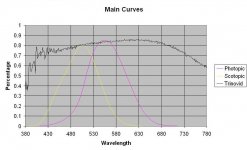Surveyor
The more I understand, the more I understand why I
Prompted by some comments in the Leica BA 8x32 thread I thought I might make some observations for general comments.
It is obvious that there is a lot of misunderstanding about the value of transmittance curves on the forum.
A transmittance curve is a radiometric measurement of spectral color and is very useful for comparing hardware to hardware but has very little meaning to the human observer. The spectral information is generally a lot higher than either the photopic curve for daytime viewing or the scotopic curve for night time viewing of the average human eye. The transmittance curve is severely truncated to the respective daytime or nighttime sensitivity of the human eye.
Brightness, a perception, not a measurable metric, is related more to the correlated color temperature of the curve as established by CIE standards. Generally, for a given illuminate, the higher the CCT the more the perceived brightness will be.
The CCT and CRI have a profound effect on how the eye perceives color. The color perception is related to how well the CCT and CRI (color rendering index) matches the eyes perception of the CCT of the atmosphere at the time of observation.
Nighttime CCT for moonlight is generally considered about 4000K for an illuminant A or B.
Daytime CCT ranges from 3000 to 7500K for D65 illuminant at various times of day and conditions.
So, unless you know your preferred illuminate, CCT, etc. and that data is published with the transmittance curve you will not know how your sight will correlate to the transmittance curve.
Most of the posts on this forum are perceptions and unless the time of day, atmospheric conditions and the photometric values are supplied by the poster it is nearly impossible to relate one observers observations to anyone else’s.
http://www.birdforum.net/showpost.php?p=3577749&postcount=5
It is obvious that there is a lot of misunderstanding about the value of transmittance curves on the forum.
A transmittance curve is a radiometric measurement of spectral color and is very useful for comparing hardware to hardware but has very little meaning to the human observer. The spectral information is generally a lot higher than either the photopic curve for daytime viewing or the scotopic curve for night time viewing of the average human eye. The transmittance curve is severely truncated to the respective daytime or nighttime sensitivity of the human eye.
Brightness, a perception, not a measurable metric, is related more to the correlated color temperature of the curve as established by CIE standards. Generally, for a given illuminate, the higher the CCT the more the perceived brightness will be.
The CCT and CRI have a profound effect on how the eye perceives color. The color perception is related to how well the CCT and CRI (color rendering index) matches the eyes perception of the CCT of the atmosphere at the time of observation.
Nighttime CCT for moonlight is generally considered about 4000K for an illuminant A or B.
Daytime CCT ranges from 3000 to 7500K for D65 illuminant at various times of day and conditions.
So, unless you know your preferred illuminate, CCT, etc. and that data is published with the transmittance curve you will not know how your sight will correlate to the transmittance curve.
Most of the posts on this forum are perceptions and unless the time of day, atmospheric conditions and the photometric values are supplied by the poster it is nearly impossible to relate one observers observations to anyone else’s.
http://www.birdforum.net/showpost.php?p=3577749&postcount=5
Attachments
Last edited:





